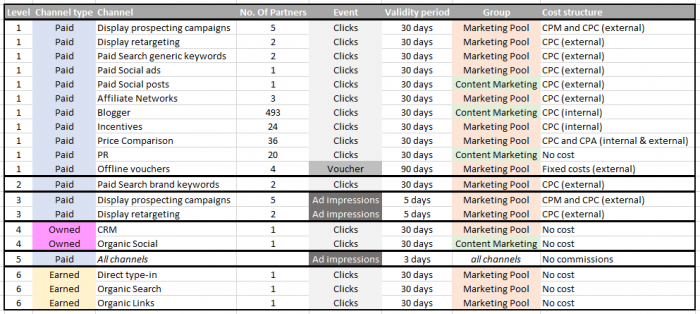We‘ve investigated the relevance of your data for attribution in part 3 of this series. We studied the amount of Single Activity Customer Journeys you have gathered and what that means for your business – after all, attribution models become unnecessary, when there is only one touch point in the customer journey.
In this article, we will study the common misunderstanding of the process AIDA, as well as the basis of building up an attribution model that fits your business needs.
The Problem with AIDA
It is human nature to sort the unknown into a framework one is aware of. Likewise, it is easy to sort all unpredictable customer journeys to reflect the well-known marketing model AIDA.
This model assumes a linear behavioural process, where the consumer becomes aware of the brand or product, reads up on it, starts to desire it and then purchases it. In terms of channels, this means the funnel begins with banner advertising on top, goes through bloggers, then price comparison and either via voucher and cashback portals or direct purchase via the website at the bottom. This sounds logical, right?
In reality, not all consumers go through this linear behavioural process. In fact, each of these channels can appear in any position.
Problem #1: The first touchpoint isn’t always the start of the decision-making process
It is just by chance that the first recorded contact point with this consumer is the first touchpoint. That does not necessarily mean that the decision process started at this point. This is particularly clear when we also study the time interval between touchpoints. It can be assumed that a banner ad impression with no further action in the next two days had no major impact on the purchase decision. Or a click on a search engine result that led to no action in the next three weeks. In such cases, a first-click model or an attention-decay model (also known as a bathtub model) have overestimated the value of the first touchpoint.
Problem #2: The position on the customer journey does not always reflect the position on AIDA
The use of certain channels determines a certain position in the decision-making process. However, it is causally incorrect to determine the importance of a channel relative to the position within a customer journey. For example, if a price comparison website is a touchpoint in the middle of a customer journey, it doesn’t mean the customer is now automatically in the Desire phase. Instead, it could be the channel where the consumer gets to know another product they were unaware of before.
This projects the problem of prefabricating attribution models that force a raster on a customer journey. Decision-making processes are chaotic. They jump back and forth within an assumed AIDA model, just as a consumer’s interest in a brand or product grows and fades easily.
Building your own attribution model
Now that we’ve understood the principles of attribution, let’s build up the scenario together:
You have defined sales targets, a suitable marketing strategy, and several years of data and experience from multiple marketing channels. Your intention is to identify strong areas in your marketing channels, and to optimize your strategy in real-time for even more success. So let’s build up a deterministic attribution model, which (as mentioned in part 1) is most appropriate when you are defining a set of rules based on a clear intention.
What else should you consider when building up your attribution model?
- Different cost structure
Your cost allocation can very a lot. After all, your display ads have CPM and CPC cost structures, affiliate networks and your direct network of publishers have CPA commissions. And you have voucher campaigns or different commission rules for your publishers to attract new and existing customers. Therefore, you must ensure this attribution model allows multiple winners, based on their respective cost model. - Clicks and ad impressions
Clicks on your ads are easy to measure. But are you also interested in finding out the indirect effect of advertising on your reach? Particularly if you spend a large amount of budget on it, you probably would. In that case, it would make sense to have ad impressions attributed differently… if possible.Naturally, you would want to define different validity periods for clicks and for ad impressions. After all, if an action taking place after 2 weeks of an ad impression, it may not necessarily be due to the ad impression. This is arguably still valid for a click on an ad, since it’s an active action. - Groups
To map your marketing funnel in the attribution model, you can arrange all display partners, affiliates, paid search and organic sources into one attribution group “Marketing Pool”. From previous analyses, your bloggers have no chance to be the winner whenever there is SEM or incentivized advertising present, even though they have a positive impact on your brand. Since they are paid by performance, they get their own attribution group.Furthermore, when it comes to Facebook Ads, you would want to track and reward promoted posts separately from banner ads. Promoted posts belong to the “Content Marketing” group, and are attributed with lower weighting. This way, they only win if no blogger contact was included in the validity period.
Let’s unveil an attribution model that takes all of the above into consideration:
In this case, level 1 has the highest weightage, and level 6 has the lowest. This means, the last level 1 channel in a customer journey will win, whereas the last level 6 channel will only win if the channels in all other levels do not appear in the customer journey. This is, of course, only if they are valid within their individual attribution periods.
So – now we have studied the macro environment of attribution, the factors that affect data tracking accuracy, the proportion of your data that is relevant for attribution, and now building up our hypothetical attribution model together. Before we bid farewell to our Attribution in E-Commerce series, we have one last important instalment that will help you decide for your business, how much of these have been realistic and practical enough to be carried out for your business. Stay tuned!
Here is part 4 of the masterclass by COO Robert Schneider. The masterclass was held in German.
Catch up on the rest of the Attribution in E-Commerce Series: Part 1 | Part 2 | Part 3 | Part 5









